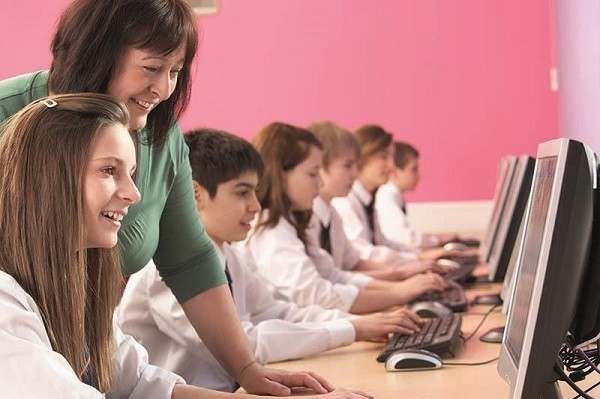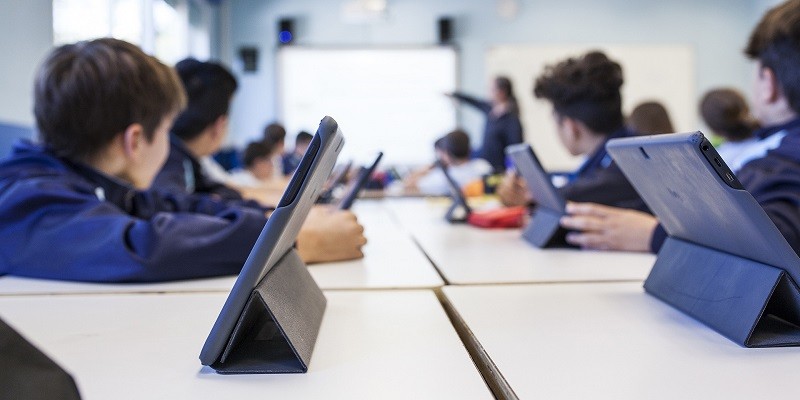Last Updated on May 9, 2025 by Jim C.
Technology plays a pivotal role in modern learning environments as it enables a more efficient and interactive educational experience. In today’s rapidly evolving world, the integration of technology in education has transformed traditional classrooms into digital hubs that foster collaboration, engagement, and personalized learning.
With the aid of technology, students can access vast amounts of information, connect with experts worldwide, and learn at their own pace. Moreover, educators can leverage various tech tools to create dynamic lessons, track student progress, and provide timely feedback.
As technology continues to advance, its potential to revolutionize education is boundless, allowing for immersive virtual reality experiences, artificial intelligence-enabled personalized learning, and adaptable learning platforms. The harmonious integration of technology and education has the power to shape a more inclusive, efficient, and innovative learning landscape.

Evolution Of Educational Technology
Educational technology has undergone a remarkable transformation, shaping modern learning environments into interactive and adaptive spaces. The evolution of educational technology has significantly impacted traditional classroom settings, offering diverse opportunities for personalized and effective learning experiences.
Historical Overview
The history of educational technology dates back to the introduction of audio-visual aids in classrooms, such as slide projectors and filmstrips in the early 20th century. This later expanded to include overhead projectors, VCRs, and televisions, signaling the first steps toward integrating technology into educational settings.
The emergence of personal computers in the 1980s brought a new dimension to educational technology, facilitating the introduction of computer-assisted instruction and educational software. The advent of the internet in the 1990s further revolutionized educational technology, providing access to vast educational resources and online learning platforms.
Impact On Traditional Classroom Settings
The integration of educational technology has redefined traditional classroom settings, fostering interactive and collaborative learning. With digital tools, students can engage in immersive learning experiences, utilizing multimedia resources and interactive simulations to grasp complex concepts more effectively. The incorporation of Learning Management Systems (LMS) has streamlined administrative tasks for educators and empowered students to access learning materials from anywhere, promoting flexibility and accessibility.
Additionally, educational technology has facilitated the adoption of personalized learning pathways, allowing for tailored instruction to meet individual learning needs. Students benefit from adaptive learning platforms that adjust content based on their proficiency, enhancing comprehension and retention of information. The technological evolution has also led to the emergence of virtual classrooms, enabling remote learning and collaborative projects across diverse geographical locations.
Benefits Of Tech-enabled Education
Discover the advantages of tech-enabled education for modern learning environments. Technology enhances engagement, accessibility, and personalized learning experiences, fostering a dynamic educational landscape. Students benefit from interactive tools and digital resources, improving their overall academic success.
Increased Access To Education
Technology has revolutionized education, breaking down barriers and providing increased access to learning opportunities.
Gone are the days when students were limited by their geographical location or lack of resources. With tech-enabled education, learning is no longer confined to the traditional classroom setting and textbooks.
Through online platforms and virtual classrooms, students can access educational resources, courses, and lectures from anywhere in the world.
For those in remote areas or with physical limitations, technology opens up a world of educational possibilities.
Moreover, flexible scheduling options allow students to learn at their own pace, fitting education around their commitments.
Enhanced Learning Experience
Technology has transformed the learning experience, making it more engaging, interactive, and tailored to individual needs.
Through multimedia content, such as videos, animations, and interactive simulations, complex concepts become more comprehensible and captivating.
Visual and auditory elements appeal to different learning styles, ensuring that students can grasp and retain information effectively.
Furthermore, technology enables personalized learning experiences. Adaptive learning platforms analyze the individual’s progress and provide targeted feedback and recommendations for improvement.
Collaborative tools and online discussion boards foster communication and interaction among students, encouraging a sense of community and shared learning.
In addition, digital assessment methods offer immediate results, allowing both students and teachers to track progress and identify areas for growth.
Challenges And Considerations
In the rapidly evolving landscape of education, the integration of technology has revolutionized the way we learn and teach. However, with every innovation comes a set of challenges and considerations that need to be addressed. From bridging the digital divide to safeguarding privacy and security, these issues demand our attention to create truly inclusive and effective tech-enabled learning environments.
Digital Divide
The digital divide refers to the gap in access to technology and internet connectivity among students. This disparity can hinder the effectiveness of tech-enabled education, as students without access to devices or reliable internet face significant obstacles in fully participating in online learning.
To bridge the digital divide, schools, and policymakers must prioritize providing necessary resources to students from disadvantaged backgrounds. This can involve initiatives such as equipping classrooms with suitable technology, expanding internet access in underserved areas, and offering devices or affordable connectivity options to students who need them.
However, addressing the digital divide goes beyond mere access to technology. It is essential to also consider factors like affordability, digital literacy, and language barriers. With a comprehensive strategy, educators and policymakers can ensure that technology reaches all students, enabling a more equitable learning experience for everyone.
Privacy And Security Concerns
Privacy and security concerns surrounding technology in education are also critical. As we rely more on digital platforms and online tools, it becomes imperative to protect the sensitive data of students, educators, and institutions.
Ensuring the privacy and security of educational technology involves implementing robust security measures, encryption protocols, and access controls. It is important to be vigilant about potential risks and stay updated with best practices for data protection.
Moreover, transparency and understanding the data collection and usage practices of educational technology providers are paramount. Institutions must carefully evaluate the tools and applications they integrate into their learning environments to ensure compliance with privacy regulations, like the Family Educational Rights and Privacy Act (FERPA).
A proactive approach to privacy and security will not only safeguard sensitive information but also foster trust and confidence in tech-enabled education, allowing teachers and students to fully explore the benefits of technology without compromising their privacy.
Ultimately, by acknowledging and effectively addressing the challenges of the digital divide and privacy concerns, we can create a more inclusive and secure tech-enabled learning environment for all.
Future Trends In Edtech
As technology continues to evolve, the future of educational technology (EdTech) holds exciting possibilities for enhancing learning experiences. Let’s delve into some key future trends that promise to shape the landscape of modern education.
Personalized Learning
In the realm of EdTech, personalized learning is set to become increasingly prevalent. Through adaptive learning algorithms, students can receive tailored educational content that caters to their individual learning styles and pace, fostering a more engaging and effective learning experience.
Virtual Reality In Education
Virtual reality (VR) has garnered significant attention as a transformative tool for education. By immersing students in simulated environments, VR enables experiential learning, allowing them to engage with subject matter in a profoundly immersive and interactive manner.
Frequently Asked Questions
What Is The Impact Of Technology In Education?
Technology enhances learning opportunities, engagement, and collaboration among students in modern educational settings.
How Does Tech-improve Student Outcomes?
Technology aids personalized learning, assessment, and feedback mechanisms leading to improved academic performance.
Can Technology Disrupt Traditional Teaching Methods?
Technology introduces interactive tools, adaptive learning platforms, and diverse resources to transform teaching approaches.
Why Is Digital Literacy Crucial For Students?
Digital literacy equips students with essential skills for navigating, evaluating, and creating information using technology.
How Does Technology Promote Global Learning?
Technology enables students to connect with peers worldwide, fostering cultural understanding and collaboration for holistic learning experiences.
Conclusion
In today’s modern learning environments, technology plays a crucial role in enhancing educational experiences. With the integration of tech tools, students can engage in interactive and personalized learning, improving their comprehension and retention. As the digital landscape continues to evolve, the potential for tech-enabled education to revolutionize the way students learn and educators teach is limitless.

